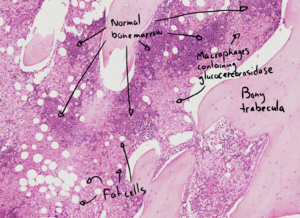14. Gaucher’s disease: Difference between revisions
(Created page with "'''Staining''': HE '''Organ''': Bone marrow '''Description''': The characteristics of normal bone marrow can be seen: Bony spicules/trabeculae, fat cells and basophilic regions with megakaryocytes and other cells. However, some regions are more eosinophilic, comprised of macrophages with very pale cytoplasm. '''Diagnosis''': Gaucher’s disease '''Theory''': Deficiency of the glucocerebrosidase enzyme causes accumulation of the glycoside glucocerebroside. Gaucher...") |
(No difference)
|
Revision as of 09:08, 9 May 2022
Staining: HE
Organ: Bone marrow
Description:
The characteristics of normal bone marrow can be seen: Bony spicules/trabeculae, fat cells and basophilic regions with megakaryocytes and other cells. However, some regions are more eosinophilic, comprised of macrophages with very pale cytoplasm.
Diagnosis: Gaucher’s disease
Theory:
Deficiency of the glucocerebrosidase enzyme causes accumulation of the glycoside glucocerebroside. Gaucher’s disease is therefore a lysosomal storage disease.
The bony trabeculae, fat cells and dark regions are components of normal bone marrow. The accumulation of glucocerebroside causes macrophages to be filled with this glycoside, making the macrophages’ cytoplasm very pale. Because macrophages occupy a large portion of the normal bone marrow will the function of the bone marrow be impaired, causing pancytopaenia.
This slide is taken from a bone marrow biopsy, which is why it’s comprised of fragments of the bone marrow.
Two types of Gaucher’s disease exists. Type 1 is the non-neuronopathic type. In type 1 is only the bone marrow affected, causing pancytopaenia. Type 2 is the neuronopathic type, meaning that the CNS is affected in addition to the bone marrow. Patients with type 2 Gaucher’s disease will have CNS complication in addition to the pancytopaenia.



